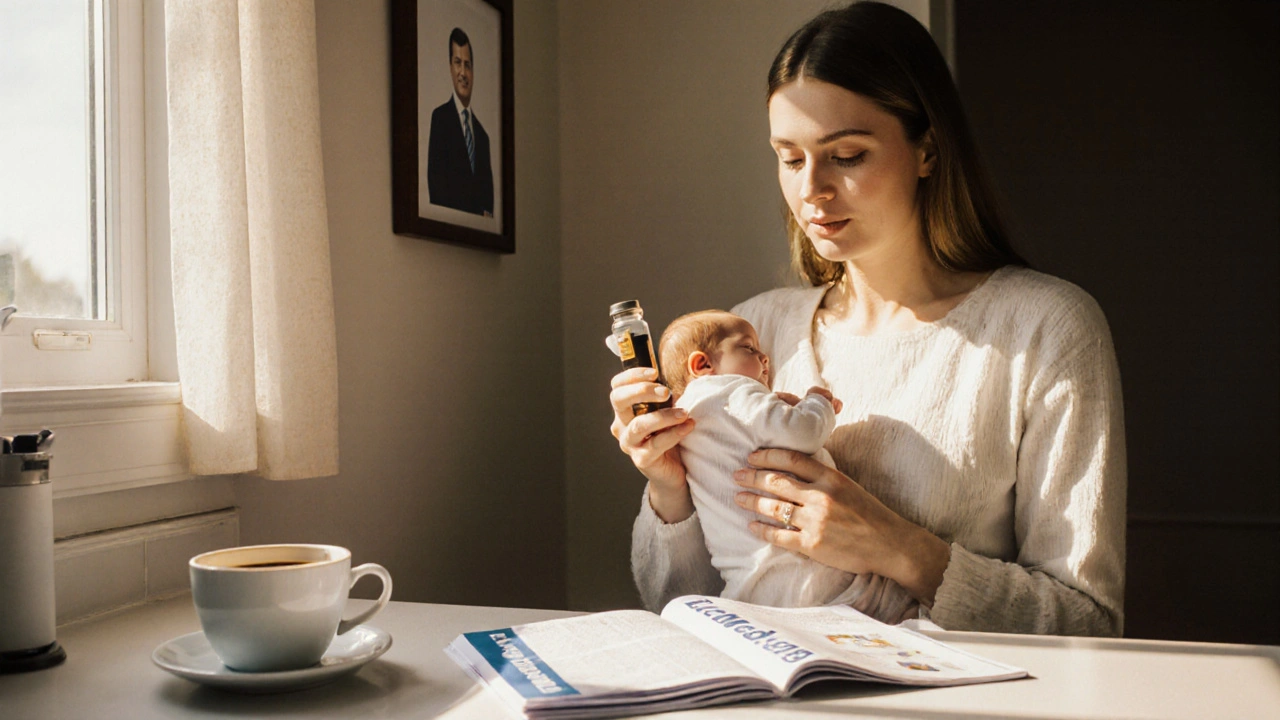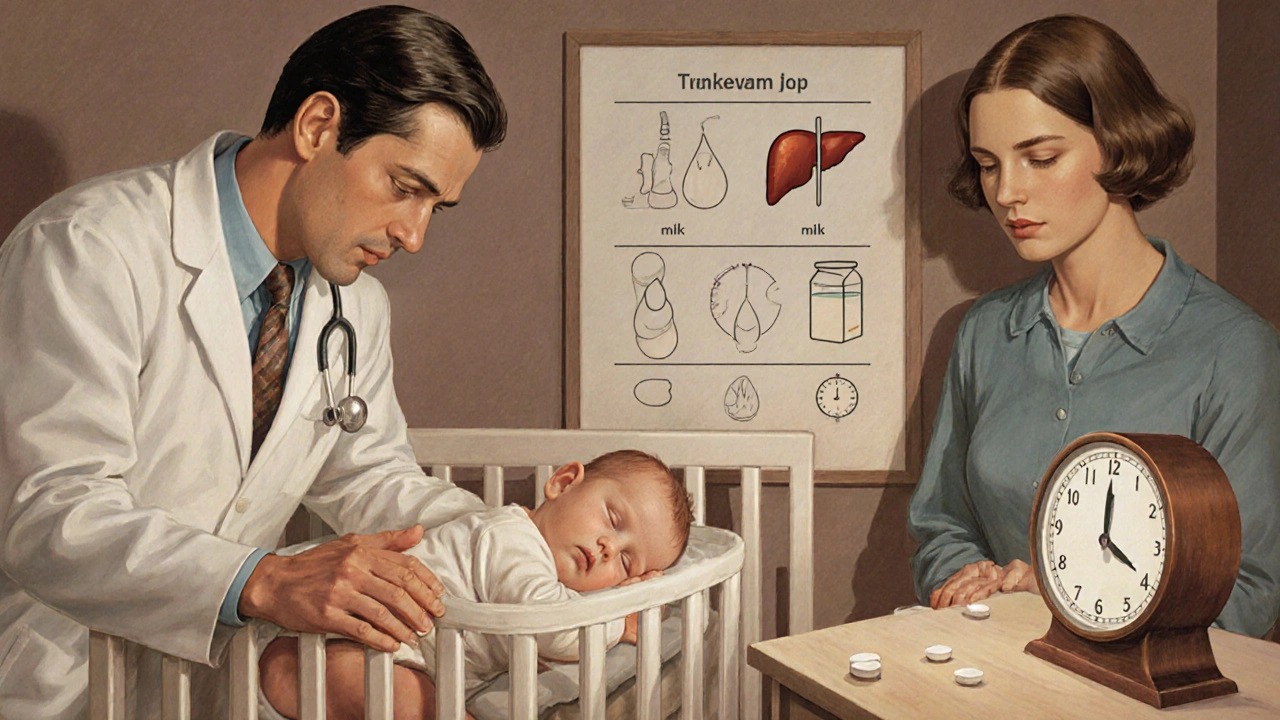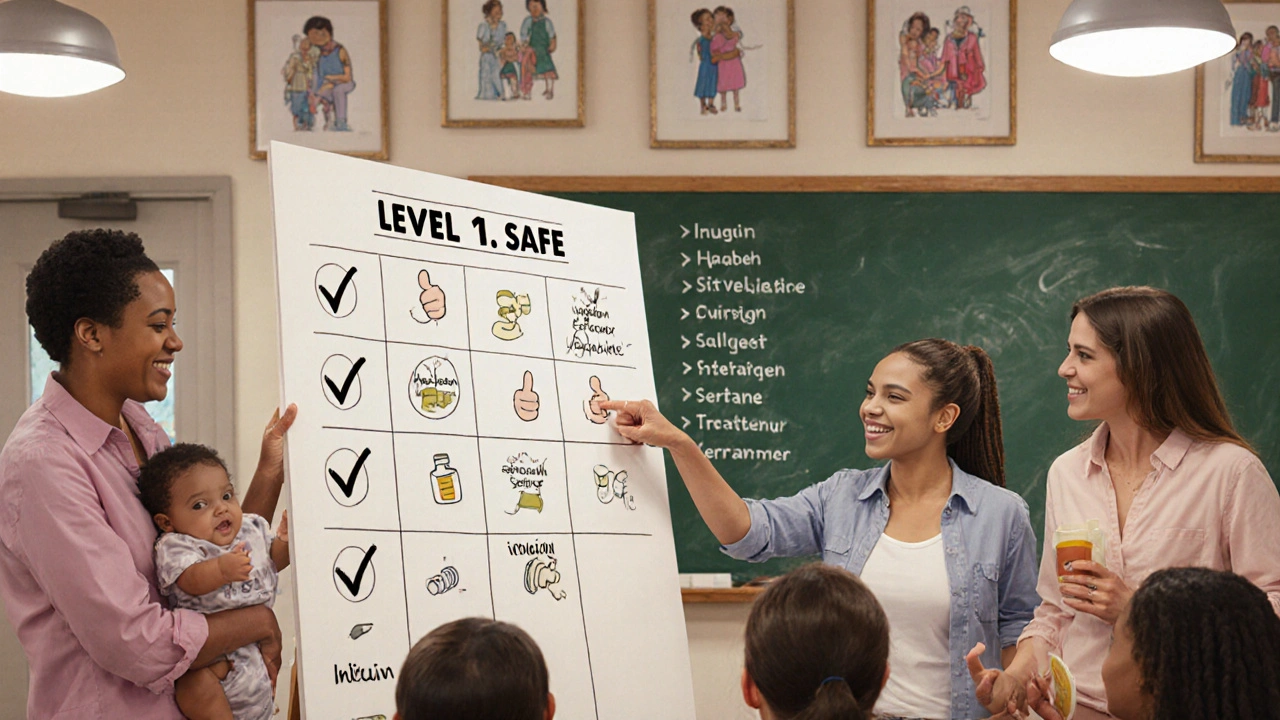How Medications Enter Breast Milk and What It Means for Your Baby
 Nov, 23 2025
Nov, 23 2025
When you’re breastfeeding and need to take medicine, it’s natural to worry: is this drug going to hurt my baby? You’re not alone. Nearly 56% of breastfeeding mothers take at least one medication, and almost a quarter stop nursing because they’re afraid of what the drug might do. But here’s the truth most doctors don’t tell you: 98% of medications are safe to take while breastfeeding. The real issue isn’t whether drugs get into breast milk-it’s understanding how much, how fast, and what actually matters for your baby.
How Medications Get Into Breast Milk
Medications don’t magically appear in your milk. They travel from your bloodstream, through tiny gaps in the breast tissue, and into the milk ducts. This happens mostly through passive diffusion-about 75% of the time. Think of it like water seeping through a sponge. If a drug is small enough, fat-soluble, and not tightly bound to proteins in your blood, it slips easily into milk.Size matters. Drugs under 300 daltons (like lithium or sertraline) cross easily. Anything heavier than 800 daltons-like heparin, which weighs 15,000-barely makes it through. That’s why blood thinners like heparin are considered safe: your baby gets almost nothing.
Lipid solubility is another big factor. Drugs that dissolve well in fat, like diazepam or alprazolam, concentrate more in milk. That’s why some moms notice their baby gets sleepier after they take a benzodiazepine. On the flip side, water-soluble drugs like gentamicin or insulin barely transfer at all. Insulin? Safe. It’s too big and too watery to make the trip.
Protein binding is the silent gatekeeper. If a drug sticks tightly to proteins in your blood (like warfarin, which is 99% bound), it can’t float freely into milk. That’s why even though warfarin is a powerful drug, less than 0.1% of your dose ends up in your milk. Sertraline, though also 98.5% bound, still gets through a little-about 1-2% of your dose. That’s why it’s one of the most recommended antidepressants for nursing moms.
There’s also something called ion trapping. If a drug is a weak base (like amitriptyline or codeine) and your milk is slightly more acidic than your blood (pH 7.0-7.4 vs. 7.4), the drug gets “trapped” in milk. That means concentrations can be 2 to 5 times higher in milk than in your blood. It’s not dangerous for most drugs, but it’s why some babies get fussy after mom takes certain painkillers or antidepressants.
When Transfer Is Highest-And When It’s Lowest
Many moms don’t realize that the first week after birth is the most risky-not because the drugs are stronger, but because your body is still changing. In the first 4 to 10 days postpartum, the cells lining your milk ducts aren’t fully sealed. Gaps as wide as 10-20 nanometers let through even large molecules. That’s why some medications, like certain antibiotics or even antibodies from vaccines, transfer more easily right after delivery.After day 10, those gaps close. By two weeks, transfer drops by 90%. That’s why timing matters. If you take a medication right after feeding, you give your body time to clear most of it before the next session. Waiting 3-4 hours can reduce your baby’s exposure by up to half. For drugs with long half-lives-like diazepam, which can linger in a newborn’s system for up to 100 hours-it’s even more important.
And don’t forget: your baby’s age changes everything. A 2-day-old baby’s liver and kidneys aren’t mature. They can’t process drugs like an adult. That’s why drugs like phenobarbital can build up in newborns, reaching 15% of the maternal dose per week. By 3 months, most babies handle medications much better.

What Drugs Are Safe? What Should You Avoid?
You don’t need to memorize a list. But you should know the categories. Experts like the InfantRisk Center and the American Academy of Pediatrics rate drugs on a scale from 1 to 5:- Level 1 (Safest): No detectable transfer. Examples: insulin, heparin, most antibiotics like amoxicillin and cephalexin.
- Level 2 (Generally Safe): Minimal transfer, no reported harm. Sertraline, ibuprofen, acetaminophen, levothyroxine. These are the go-tos for moms.
- Level 3 (Use with Caution): Some risk, monitor baby. Fluoxetine, lorazepam, some antihypertensives.
- Level 4 (Possibly Hazardous): Avoid if possible. Lithium, cyclosporine, certain chemotherapy drugs.
- Level 5 (Contraindicated): Don’t take while breastfeeding. Radioactive iodine-131, some cancer drugs, bromocriptine (which shuts down milk production).
Most common meds fall into Level 1 or 2. Antibiotics? Safe. Painkillers? Acetaminophen and ibuprofen are fine. SSRIs? Sertraline is the gold standard. Even birth control? Low-dose progestin-only pills are okay. But high-dose estrogen pills (over 50 mcg ethinyl estradiol) can drop your milk supply by 40-60% in just three days. That’s why many doctors recommend progestin-only options.
There are exceptions. If you’re on lithium, you’ll need blood tests for both you and your baby. If you’re taking a long-acting benzodiazepine like clonazepam, watch for drowsiness, poor feeding, or breathing issues. If your baby seems unusually sleepy or isn’t gaining weight, talk to your pediatrician. But these are rare.
Real Risks-And What You Should Actually Watch For
The biggest danger isn’t the drug itself. It’s the fear that makes moms quit breastfeeding. Studies show that 15-30% of women stop nursing because they’re told a medication is “unsafe”-even when it isn’t. That’s a loss. Breastfeeding reduces infections, lowers the risk of obesity, and even helps moms recover faster after birth.Here’s what to actually watch for in your baby:
- Excessive sleepiness or difficulty waking to feed (common with benzodiazepines or opioids)
- Poor feeding or weight gain (could signal sedation or reduced milk intake)
- Irritability, tremors, or unusual crying (seen in rare cases with SSRIs like fluoxetine)
- Diarrhea or rash (possible with antibiotics, but often coincidental)
Most of these symptoms are mild and temporary. In fact, a 2022 study found that only 8.7% of infants on SSRIs showed mild irritability, and it resolved without stopping breastfeeding. If your baby is feeding well, gaining weight, and seems alert most of the time, the medication is likely fine.
For high-risk drugs like lithium or certain anticonvulsants, your doctor may check your baby’s blood levels. But for 98% of medications? No blood tests needed. Just watch your baby. Trust your instincts.

What to Do When You Need Medicine
You don’t have to guess. Here’s a simple plan:- Check the source. Use the InfantRisk Center’s app (LactMed version 3.2) or consult LactMed.gov. Both are free, updated daily, and based on real data from over 2,500 drugs.
- Talk to your doctor. Don’t assume your OB or pediatrician knows all the details. Bring up your meds. Ask: “Is this safe for breastfeeding?” and “Is there a better alternative?”
- Time your doses. Take medication right after a feeding. Wait 3-4 hours before the next one. This cuts exposure significantly.
- Watch your baby. Look for changes in feeding, sleep, or behavior. If something seems off, note it and call your pediatrician.
- Don’t stop breastfeeding without advice. Most drugs don’t require it. Even if you’re on a Level 3 drug, you can often keep nursing with monitoring.
And if you’re on a medication that’s not well studied? You still have options. Many drugs have decades of real-world use. Sertraline, for example, has been safely used by hundreds of thousands of nursing moms since the 1990s. The data is there. You just need to ask for it.
The Bigger Picture
Medication use during breastfeeding isn’t about avoiding all drugs. It’s about choosing wisely. The FDA now requires all new drugs to include lactation data. That’s progress. The InfantRisk Center’s AI tool, updated in January 2023, uses 12 pharmacokinetic factors to give real-time risk scores. We’re not flying blind anymore.And here’s the most important thing: the risk of stopping breastfeeding often outweighs the risk of the medication. Babies who aren’t breastfed have higher rates of ear infections, respiratory illness, obesity, and even SIDS. Moms who stop breastfeeding early have higher rates of postpartum depression and breast cancer.
You’re not choosing between your health and your baby’s. You’re choosing how to protect both. With the right information, you can do both.

Neoma Geoghegan
November 24, 2025 AT 10:3598% safe? That’s the number that matters. Stop panicking and start trusting your body. You got this.
Pharmacokinetics aren’t your enemy-fear is.
Bartholemy Tuite
November 25, 2025 AT 06:53bro i was on sertraline while nursing my first and my kid turned into a sleepy little angel who napped 18hrs a day honestly i thought it was the meds but turns out he was just chill af like his mom
also i used lactmed like 3x and it saved my sanity no joke
ps: if ur doc says avoid it ask em if they’ve read the latest meta-analysis or if they’re just repeating what they heard in med school 2003
Sam Jepsen
November 26, 2025 AT 11:46This is the kind of post that makes me love this sub.
So many moms are scared into weaning when they don’t have to be.
Big up to anyone who shares real data over fear-mongering.
Also-sertraline is the MVP of SSRI breastfeeding meds. Period.
And yes, timing doses after a feed? Game changer. I wish I’d known that sooner.
Yvonne Franklin
November 27, 2025 AT 16:23Insulin doesn’t transfer because it’s too big and too polar. That’s basic pharmacology.
Same with heparin. No need to overcomplicate it.
Most moms just need to know: if it’s on LactMed Level 1 or 2, you’re fine.
Trust the science not the anxiety.
Julie Pulvino
November 28, 2025 AT 02:08I took ibuprofen and amoxicillin while nursing my twins and they’re now 7 and thriving.
No sleepiness. No rashes. No drama.
My pediatrician didn’t even blink when I told her I was on meds.
Turns out, most of us are fine.
And if your baby is feeding well and gaining weight? You’re doing great.
Don’t let fear steal your joy.
Patrick Marsh
November 29, 2025 AT 15:21Important note: Always check LactMed.gov. Not just any website. Not just your OB’s memory. Not just Reddit. LactMed.
Updated daily. Peer-reviewed. Free.
And yes, it says sertraline is safe. Again.
Don’t guess. Look it up.
Danny Nicholls
November 30, 2025 AT 08:03Yessssss this is the info we need!! 🙌
So many moms quit bc they’re scared, not bc it’s actually dangerous.
My cousin stopped breastfeeding because she took a Z-pack and her baby cried a little… turns out the baby just had a teething spike 😅
Also, LactMed app is a lifesaver. Bookmark it. Share it. Love it.
And hey-if you’re on meds and nursing? You’re a superhero. 💪🍼
Robin Johnson
November 30, 2025 AT 22:31Timing doses after feeding is critical for long half-life drugs.
Especially benzodiazepines.
Waiting 3-4 hours cuts infant exposure by up to 50%.
It’s not complicated.
It’s just not taught well.
And yes, the 98% stat is accurate.
Stop listening to anecdotal horror stories.
Listen to pharmacokinetics.
Latonya Elarms-Radford
December 1, 2025 AT 20:00Let’s be real: the medical industrial complex has spent decades gaslighting mothers into believing their bodies are dangerous vessels for their children.
They tell us to pump and dump, to wean, to fear our own biology-while quietly profiting off formula sales and pharmaceutical patents.
And now, you’re telling us to trust the data?
But who curated the data?
Who funded the studies?
Is it really liberation… or just a more sophisticated form of control?
Are we truly free to choose-or just given a prettier cage?
And if the FDA now requires lactation data… why did it take so long?
Why did mothers die quietly, weaning out of fear, while institutions looked away?
It’s not about sertraline or heparin.
It’s about who gets to define safety.
And who gets to profit from our doubt.
Mark Williams
December 3, 2025 AT 06:01Ion trapping effect on weak bases like amitriptyline is well documented in J Clin Pharmacol 2021.
Plasma-to-milk ratios of 2.8–4.1 for tertiary amines.
That’s why some infants show fussiness.
Not toxicity.
Just pharmacokinetic reality.
Monitor, don’t panic.
And always consider neonatal hepatic maturity.
Under 6 weeks = slower CYP metabolism.
After 12 weeks? Most drugs are handled like adults.
Context matters.
Daniel Jean-Baptiste
December 3, 2025 AT 14:45Just want to say thank you for this post.
My wife was about to quit breastfeeding because her doctor said 'maybe avoid antidepressants'-no specifics.
We checked LactMed. Sertraline Level 2.
She’s been on it for 6 months now.
Kid’s happy. Mom’s sane.
Real talk: the system fails moms every day.
You just gave us a tool to fight back.
Grateful.
Ravi Kumar Gupta
December 4, 2025 AT 00:36In India, most doctors still tell mothers to stop breastfeeding if they take any tablet.
Even paracetamol.
My wife was told to stop nursing because she took antibiotics for a UTI.
We went to a lactation consultant.
She said: 'You’re not poisoning your baby, you’re feeding him your strength.'
Now my son is 18 months and still nursing.
And yes, he’s healthier than half the kids in our village.
Stop listening to outdated advice.
Knowledge is your milk.
Rahul Kanakarajan
December 5, 2025 AT 04:5798% safe? LOL. That’s just industry spin.
Who even defined 'safe'? The drug companies?
And why do you think the FDA only started requiring lactation data last year?
Because moms kept dying from postpartum depression after being told to wean.
And now you want us to trust a chart?
Where’s the long-term neurodevelopmental data?
Where’s the 20-year follow-up?
And why are you ignoring the fact that SSRIs can alter infant serotonin receptors?
Don’t give me statistics.
Give me truth.
And stop pretending this is simple.
New Yorkers
December 6, 2025 AT 02:50Ugh. Another 'trust the science' post.
Like we haven’t heard this before.
When I was nursing, my OB said 'just pump and dump' for my migraine meds.
Then my pediatrician said 'it’s fine.'
Then my yoga teacher said 'your milk is toxic if you take anything synthetic.'
So now I’m supposed to pick one voice?
Who even are you to decide what's safe?
And why do you think your data is better than my intuition?
My baby cried for 3 hours after I took ibuprofen.
That’s not science.
That’s my child.
And you don’t get to reduce that to a percentage.